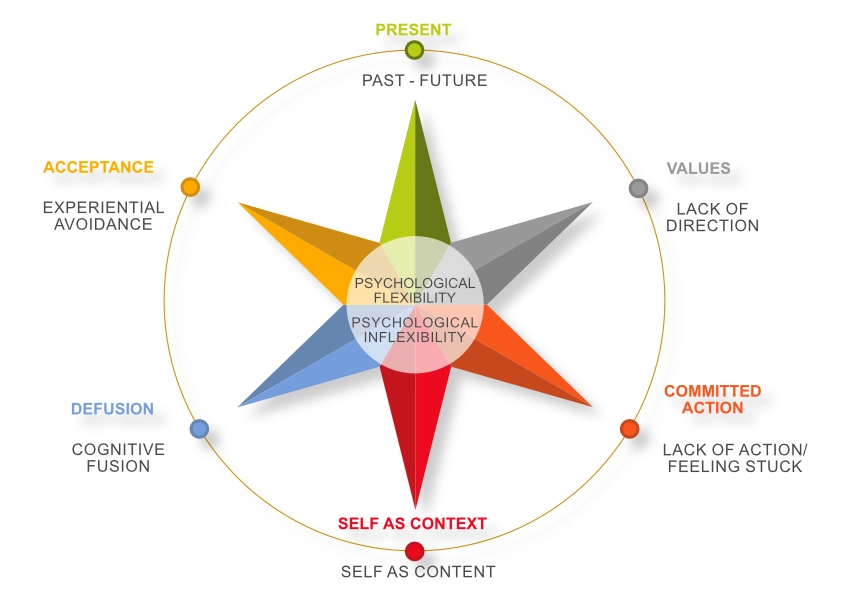Acceptance and Commitment Therapy/Training (ACT)
Tom Luken & Albert de Folter 2000 & 2012
A strange but easy way to remember the essence of Acceptance and Commitment Therapy is the following saying: “Grant me the serenity to accept the things I cannot change, the courage to change the things I can, and the wisdom to know the difference.”
Table of Content
Acceptance and Commitment Theory is
- Integrated within the contextual theory of cognition and behaviour Relational Frame Theory (RTF) (Hayes, Barnes-Holmes and Roche, 2001)
- Is related to, and builds upon CBT (Cognitive Behavioural Therapy) but is different in the sense that CBT attempts to identify and change irrational thoughts. ACT tries to change the function of cognitions, of what clients know about themselves, and aims to achieve flexibility in how these feelings and cognitions are handled by the client.
- ACT is a mix of Western and Eastern perspectives
According to ACT
- There are six interrelated elements or processes that form the psychological reality of individuals.
- You can’t control what happens in your life but you can control how you handle, look at and act upon what happens (within reason).
The client is supported to move from unhelpful states (in black below) to helpful states (in colour below) in order to resolve issues the client is. Fighting and struggling with feelings and emotions serves to make things worse and results in unhelpful behaviours. Acceptance and embracing thoughts and feelings is achieved by:
- Working within the present, rather than ruminating about the past or a future that may or may not happen – Mindfulness strategies
- Developing strong values, rather than ‘being washed around’ by life
- Committing to action, instead of residing in thought and worry
- Seeing yourself as the context of your story, rather than being the story
- Taking distance from your thoughts and seeing them for what they are, rather than fusing with your thoughts and worries
- Accepting your situation, rather than trying to avoid it through unhelpful behaviours and thought patterns

Within a career context, this approach can be especially powerful when a client is facing redundancy or a difficult situation at work they can do nothing about. The career professional supports the client to accept the situation and to focus on the now, rather than unhelpful strategies of avoidance and overfocusing on the problem at hand and the self.
How can this work in modern career guidance practice?
Cognitive defusion – Self as context rather than content
Example technique: Reframing: helping a client see that in a redundancy situation, the client isn’t the redundancy. That the redundancy is happening outside of the client as part of their story, rather than them identifying with what happened. Example technique: Using metaphor: working with the client from “I am the problem” to “the ‘problem’ is outside me and I can work on this” using the metaphor of internal/external landscape: what I see around me IS the landscape (what I think IS going on and is the only interpretation of the world around me) to the map (that I have made in my mind of the world around me) is not the landscape. This means that I can change my internal map to a more positive perspective.
Acceptance/avoidance – Present rather than future
Example technique: You could support the client in confronting the reality they are faced with in the present, rather than them applying (fantasy) thinking which avoids action that will help them escape the situation they are in. “This has happened, but these are the skills I have to get me another job” instead of “they don’t want me anymore but all I have to do is wait for my friend x to offer me another job when I tell them about my redundancy.”
Values and committed action
Example technique: Supporting the client in moving from “this always happens to people like me” to “I have a strong work ethic and have a lot to offer. I’m going to contact other employers to see if they can take me on…”. Techniques that can help here can be motivational interviewing, challenging perceptions, providing contrary evidence (other people in his company who have found a good job again) and exploring and discussing realistic options for progression.
The theory’s genetics
ACT is linked to psychological theories but also motivational interviewing and solution focused theories. It is also loosely related to Scott and Jaffe’s model of change and constructivist theories (the stories we tell ourselves), Integrative Life Planning Theory, part of Life-is-Career Theory as well as the values based theories.
This is a counselling based approach, so caution is required and the practitioner may need to engage in specific training to avoid possible harm to the client. Just like we all use counselling skills, while we are not necessarily counsellors, elements of this can be integrated in general career guidance practice, as above.
Critique
- Think about how ACT compares to other career guidance theories. How does it compare to other counselling theories for instance?
- Is ACT something you can use in your own practice?
- What are its limitations with the client group you are working with?
- What objections could different groups of clients have, and how could you get around those?
- Is this best to be used in individual consultations? Or is ACT a useful tool for workshops as well?
- Why is this theory a positive theory?
- What are its weaknesses for a career context?
Useful links
- https://www.getselfhelp.co.uk/act.htm
- https://www.psychologytoday.com/gb/blog/two-takes-depression/201102/introduction-acceptance-and-commitment-therapy
- https://positivepsychology.com/act-acceptance-and-commitment-therapy/ – this link contains a lot of resources to assess, adapt and use.
- https://www.psychologytoday.com/gb/therapy-types/acceptance-and-commitment-therapy
- https://www.goodtherapy.org/learn-about-therapy/types/acceptance-commitment-therapy
- https://www.aipc.net.au/articles/six-principles-of-acceptance-and-commitment-therapy/ a more in depth exploration of the 6 basic principles of ACT
- https://contextualscience.org/act
Further reading
- https://www.academia.edu/37138654/ACT_as_Innovation_for_Career_Guidance
- https://tom-luken.nl/ACTfuels.pdf
Video
Feel free to listen to the introduction, which in itself may be useful. Tom Luken starts at 04:02.






